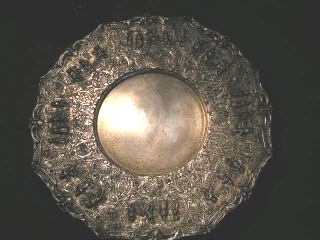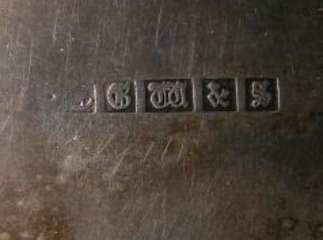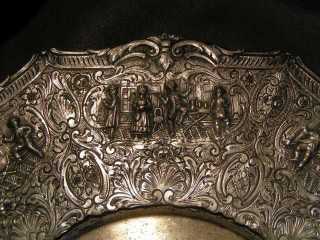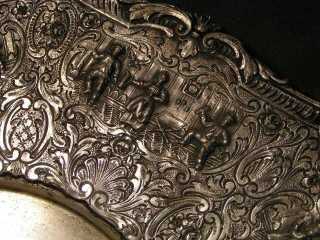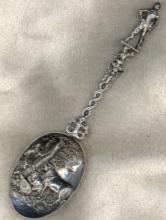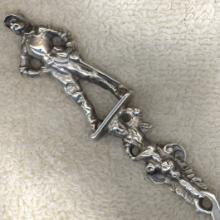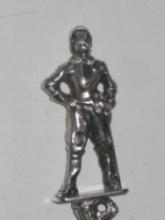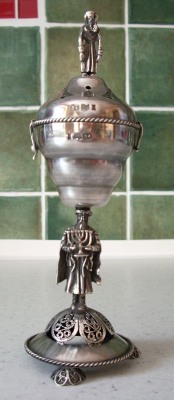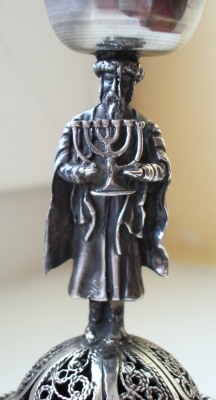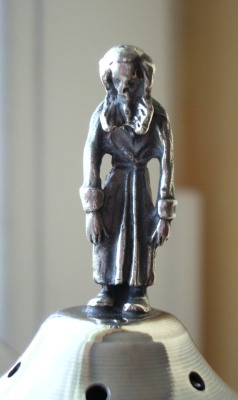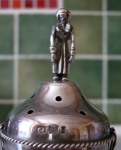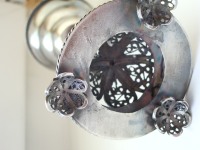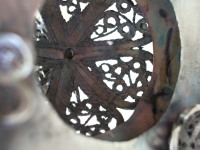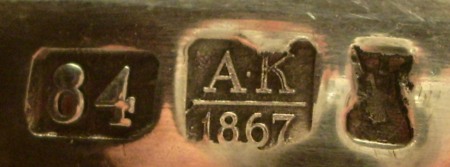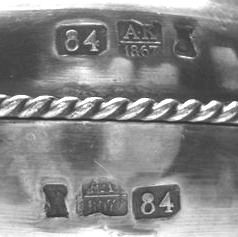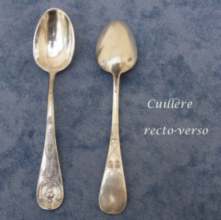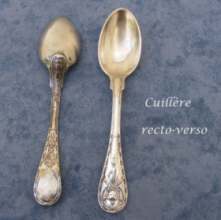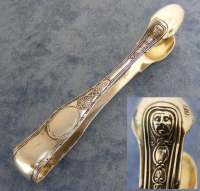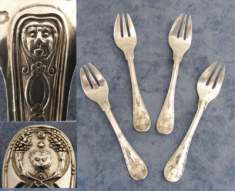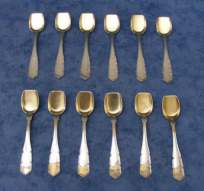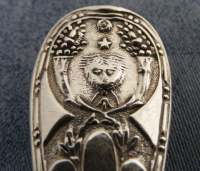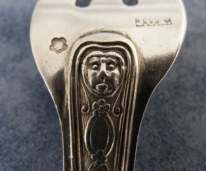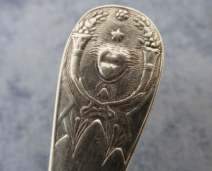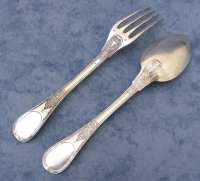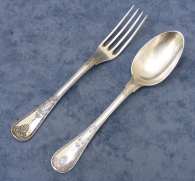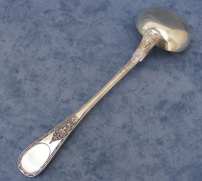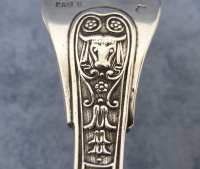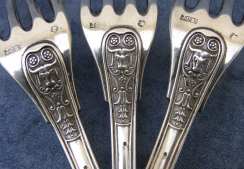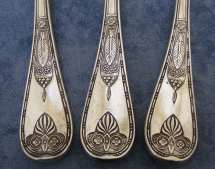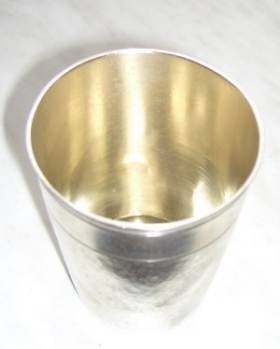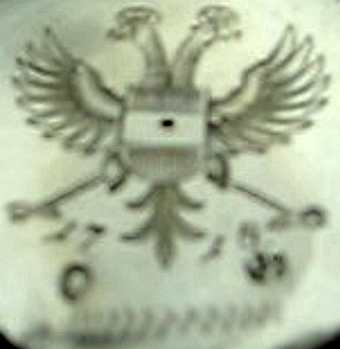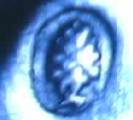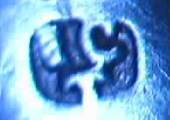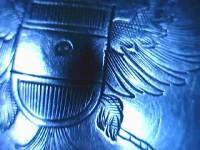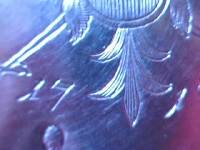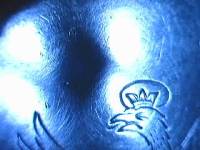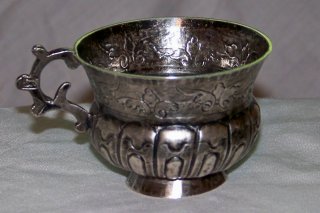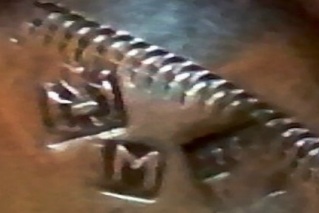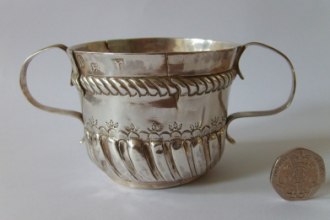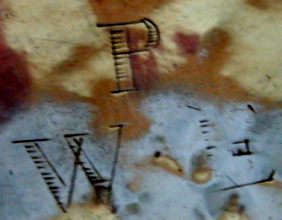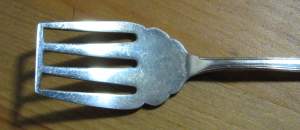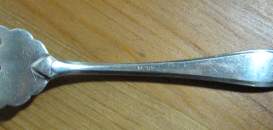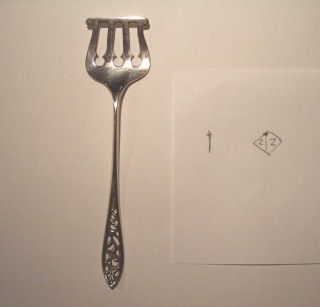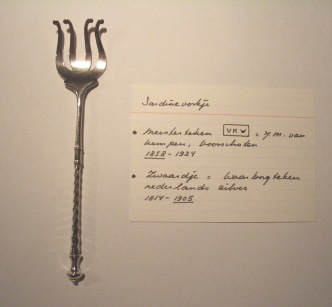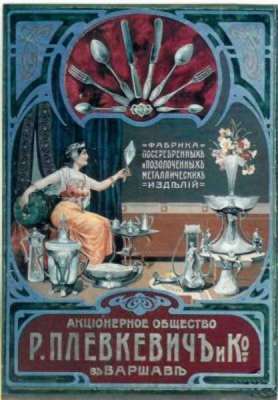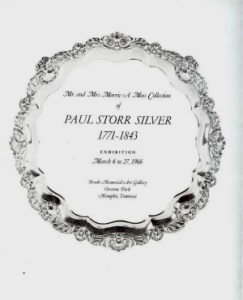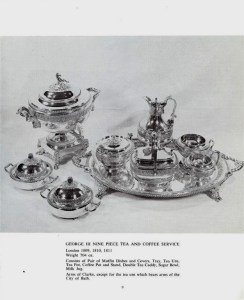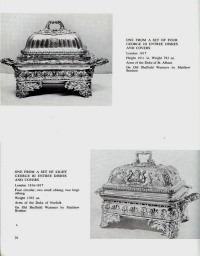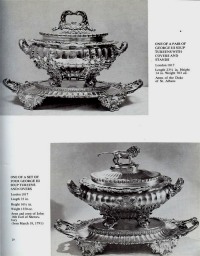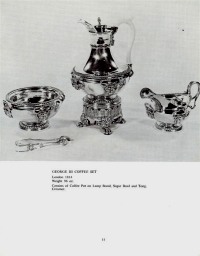 newsletter # 49 - JUNE 2008
newsletter # 49 - JUNE 2008www.ASCASonline.org
email: silverassociation@yahoo.it
YOUR GUIDE TO JUNE NEWSLETTER:
articles new members
members' window
|
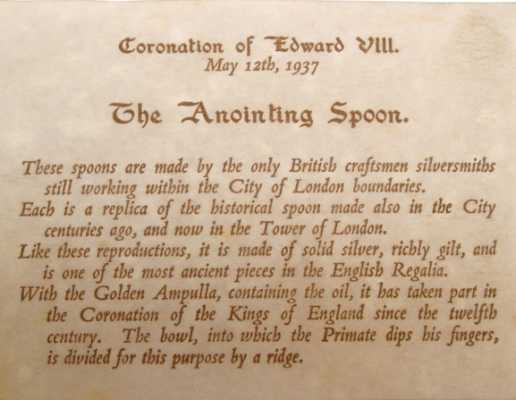
Jack F. Wilson presents: with the addition of the List of Silversmiths present in Jack F. Wilson Collection and other makers known to the author- part 2 -...Examples of teaspoon-sized replicas with highly abbreviated ornamentation began to appear in or around 1910. There were vestigial remnants of some of the ornamentation on the original spoon found on these examples, but many were definitely made utilizing stamping machines and not cast. Earlier examples were made up of cast [and sometimes stamped] parts sweated together. Often the bowl engraving on the earlier examples was cast, but many of these castings were refined by hand chasing. Bowl shape varies as well. Some are rather narrow, others broad-ranging to almost round. I have a few examples of a spade-shaped bowl. Also around this time smaller versions to be used as salt and mustard spoons began to appear........ click here |
New members
Welcome to new ASCAS members:
Jonathan Barber - USA
Susan Buck - USA
Mary Conner - USA
Cesare Antonio Maria de Stanchina - Italy
Ron H. Dubberly - USA
Elizabeth Duckworth - USA
Brian Hawley - USA
Josephine Lewis - USA
Karen Nardella - USA
Zélia Soares - Austria
Members' Window # 49


|
Mail to ASCAS: e-mail silverassociation@yahoo.it
Marianne Gearin writes:
... I am trying to identify a plate that I purchased at a flea
market. I am not a regular collector but was attracted to it. I
have searched all over to identify the Hallmark with no success.
Are you able to, or could you please direct me to someone who
can help me.
A footnote: under the hallmark appears to be an engraving that
looks like it reads Ely10. Thank you in advance for your help.
Best Regards,
Thanks
Marianne Gearin
The marks on your photos are not well readable. Anyway I
believe that this spoon was made in the Netherlands but I'm
unable to identify the maker and to date it.
I hope that someone of ASCAS members with deep knowledge of
Dutch marks will be able to reply to your question. Giorgio
Busetto
On my opinion, your item isn't ancient Russia silver.
Further information about "fakes" and images of items with
similar ornaments are available in my website at
http://www.silvercollection.it/fakesbis.html.
Other comments by ASCAS members will be highly appreciated
WARNING: this is NOT an appraisal. I have no title to make
appraisals and this is only my PERSONAL OPINION.
Giorgio Busetto
Christophe Ginter writes:
....Please find herewith a picture of an Austrian silversmith
unknown to me. Initials JCK. Active in the 1860s, in Vienna?
Many thanks in advance for your reply.
With my kind regards.
Christophe Ginter
The maker is Joseph Karl (Carl) KLINKOSCH.
Born in Vienna, 28 February, 1822. Son of Carl Klinkosch and of
Katharina Kempenich.
Apprentice to his father from 1835 to 1839. Registered as master
silversmith January 25, 1944 he became responsible for the
family firm in 1843.
From 1855 he was Viennese Court's supplier for silver and gold
items.
From 1864 to 1870 he was in partnership with Stefan Mayerhofer
under the style Mayerhofer & Klinkosch. The firm was present at
World Exhibitions of Vienna (1873) and Paris (1878).
After the dissolution of the partnership he became the manager
of the firm J.C Klinkosch.
After his retirement in 1884 the firm was managed by his sons
Arthur (1884-1899) and Isidore (1884-1914).
Giorgio Busetto
Zelia Soares writes:
... I am sending some photos of my beaker - 8,5 cm tall 6,5 cm
diameter.
It weights approx. 300 grams. It has an Augsburg hallmark, date
mark 1718, and another hallmark that I can’t identify, probably
the initials of the Augsburg silversmith, but I don't know who.
Although I was not able to recognize the mark of Double-Headed
Eagle. I have searched since I got it in 1988. I found many
kinds of double-headed-eagle (Hapsburgs, Lubeck, Masonry or...),
but no one is like mine.
The only thing right is this beaker came from somewhere in
Europe, made by some silversmith from Augsburg (pinecone mark).
I sincerely hope some member can help me.
Thanks in advance,
Zelia Soares
an anonymous reader writes:
... An old teacup or (?) vodka cup, I have been searching to
find more info. I cannot find hallmarks in any books I have
looked in so far.
Ever seen it before? I took closest pictures I could, but town
mark appears to be two men on either side of a forge.
Thanks in advance if you have time to look.
Your cup is a "charka" . A wide informative article about
this drinking vessel written by Kari Helenius is available in
ASCAS website at
http://www.ascasonline.org/articoloOTTO68.html
The marks of your charka aren't well readable. I have only a
hypothesis of identification:
town mark: Novgorod (mark #3093 or 3095 in Postnikova-Loseva)
maker: AM, unidentified master 1753-1774 (mark # 3108 in
Postnikova-Loseva).
Any further information from members well acquainted in Russian
silver will be welcome.
Giorgio Busetto
Replies to questions
| Mike Whitehead
receives this reply about his silver cup
( see May Newsletter) Giovanni Ciceri writes: ... It is a porringer, a vessel used for infusions.
This kind of item was popular in the late XVII and in
the beginning of XVIII century, during the reign of
William and Mary. William III, and Queen Anne. Many
replicas have been produced in the late XIX century with
the same design, but usually of greater dimension being
used as sugar bowls.
|
| Eric
Schneider receives this reply about his Russian
flatware
( see October 2006 Newsletter) Geldolph Everts writes: ... I just discovered the wonderful website
of ASCAS and blissfully surfed around for many
hours.
|
|
Nancy Zarod
receives these replies about her unusual
fork
( see May Newsletter) Maja Houtman writes: ... This fork is called in Dutch a
sardinevork.
|
|
Giovanni
Ciceri sent these comments to
Jack F. Wilson article
"ANOINTING SPOON REPLICAS - part
1-"
( see article # 97) Dear Jack, I read with great interest your article about anointing spoons as I was a collector of commemorative British silvers (I also wrote an article about these for ASCAS, in which I reported one of the three examples I have in my collection). I have not your skill in this field but from what I was able to see in my research of commemorative items I agree that occasionally one can find an anointing spoon hallmarked outside the coronation date, but it is the a matter of fact that the greatest number of this replicas available on the market follow in the coronation years or just around them (maybe for commercial or business considerations). It is not clear from the text of your article if you also considered other important royal anniversaries (marriages – not only of the king/queen but also of other members of the royal family, jubilee, etc.): I think that some of the reported dates can be explained with these events, but I have not investigated this. I remember an example of an anointing spoon hallmarked in Birmingham and dating 1897 (diamond jubilee of Queen Victoria) of which I have no record because the auction was not won by me. About the variety of the Assay Office: apart Birmingham and London, the few cases I noted were hallmarked in Chester (where there was no significant silversmith activity in the second half of XIX century) and Sheffield but always manufactured by large companies and not by local silversmiths. The same seems to apply for Glasgow and Edinburgh: are the examples to which you refer hallmarked by local silversmiths or by large manufactures? I hope you appreciate my contribution. Giovanni Ciceri www.Argentinglesi.com "A PAGE per MONTH"In
this column we present a page
obtained from makers' brochures,
books, auction catalogs,
advertising or whatever other
printed paper related to silver,
which may be of interest for
ASCAS members.
|
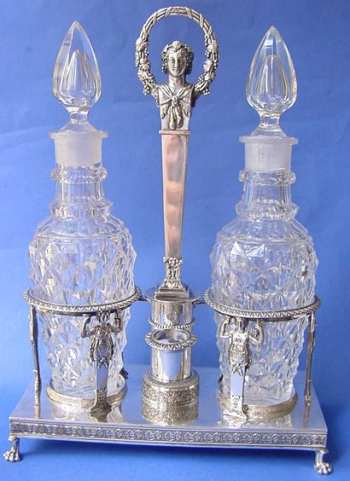
|
CRUET STAND
|
"A BOOK ON MY SHELF"
In
this column we present books,
new or ancient, dealing with
silver in all its aspects
(history, marks, oddities...).
This isn't a "book review" but
only a fair presentation of some
useful "tools" that anyone may
have in the shelf of his
bookcase.
ASCAS members are invited to
contribute to this column
(click to enlarge images)
The "book on the shelf" of
this month is presented by Karin
Sixl-Daniell:
MR. AND MRS. MORRIE A. MOSS
COLLECTION
OF PAUL STORR SILVER
1771 - 1843
Exhibition March 6 to 27,
1966
Brooks Memorial Art Gallery
Overton Park
Memphis, Tennessee 1912
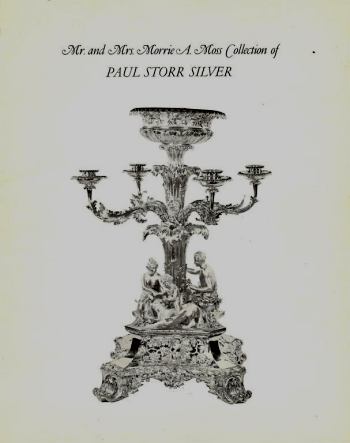 |
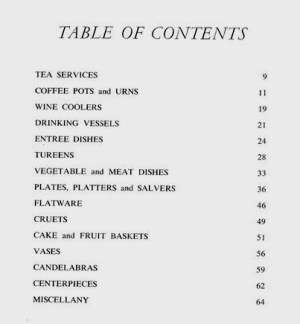 |
SILVER SOCIETY OF CANADA
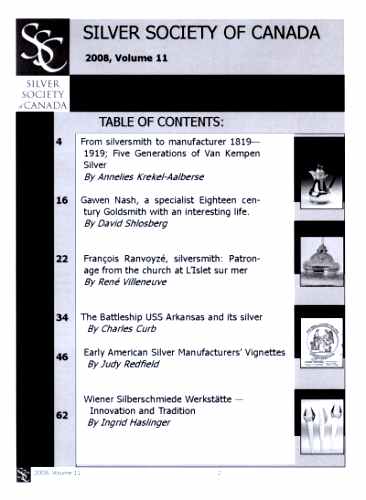
|
The Silver Society of
Canada celebrates its
10th anniversary. SSC just published its JOURNAL 2008 VOLUME 11, a breathtaking 132 pages edition with interesting articles by many renown international writers. People interested may contact SSC through its President, Dorothea Burstyn, at DBURSTYN@ROGERS.COM 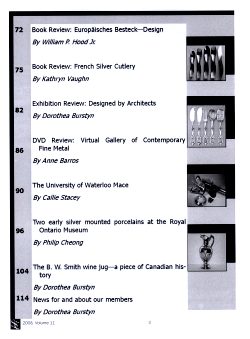
|
Closing our JUNE 2008 edition of ASCAS Newsletter I hope you have appreciated its content.
Your comments, suggestions and advice will be of great help.
My thanks to A. Branislav, Giovanni Ciceri, Jayne Dye, Geldolph Everts, Marianne Gearin, Christophe Ginter, Rod Hall, Maja Houtman, Martin Leushuis, Howard Schecter, Karin Sixl-Daniell, Zelia Soares, Michael Urban, JoAnne Wilkinson, Jack F. Wilson, for their invaluable contributions.
Giorgio Busetto
Secretary
ASCAS is a community
of people having a
common interest in
antique silver.
|
|
|

